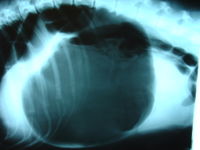
Photo from wikipedia
Objective To determine the prevalence of intraoperative gastroesophageal reflux (GER) and postanesthetic vomiting and diarrhea, and to evaluate risk factors associated with these gastrointestinal disorders (GID) in dogs undergoing general… Click to show full abstract
Objective To determine the prevalence of intraoperative gastroesophageal reflux (GER) and postanesthetic vomiting and diarrhea, and to evaluate risk factors associated with these gastrointestinal disorders (GID) in dogs undergoing general anesthesia. Design Prospective observational study. Setting University teaching hospital. Animals Two hundred thirty-seven client-owned dogs undergoing general inhalant anesthesia for diagnostic or surgical purposes. Interventions None Measurements and Main Results Patient, surgical, and anesthetic variables, and postanesthetic treatments administered in the immediate postanesthesia period were evaluated in relation to GID using univariate and multivariate logistic regression analysis (P < 0.05). Seventy-nine of the 237 (33.4%) dogs developed GID during the perianesthetic period. The prevalences of GER, vomiting, and diarrhea were 17.3%, 5.5%, and 10.5%, respectively. Intraabdominal surgery (P = 0.016; odds ratio [OR] 2.82, 95% confidence interval [CI]: 1.21–6.62), changes in body position (P = 0.003; OR 3.17, 95% CI: 1.47–6.85), and length of anesthesia (P = 0.052; OR 1.006, 95% CI: 1.000–1.013) were associated with GER. Changes in the ventilation mode during surgery (P = 0.011; OR 6.54, 95% CI: 1.8–23.8), length of anesthesia (P = 0.024; OR 1.001, 95% CI: 1.001–1.020), and rescue synthetic colloid support due to hypotension (P = 0.005; OR 6.9, 95% CI: 1.82–26.3) were positively associated with postanesthetic vomiting. On the contrary, dogs that received acepromazine as premedication were significantly less likely (P < 0.019; OR 12.3, 95% CI: 1.52–100) to vomit. Finally, length of anesthesia, changes in body position, changes in ventilation mode, or hypoxemia during the procedure tended to increase the risk (univariate model) of diarrhea during the recovery phase. Conclusions GID are common in dogs undergoing general anesthesia. Duration and characteristics of the procedure, anesthetic management, and changes in certain patient variables are significant risk factors for the presence of GID in the perioperative period.
Journal Title: Journal of Veterinary Emergency and Critical Care
Year Published: 2017
Link to full text (if available)
Share on Social Media: Sign Up to like & get
recommendations!